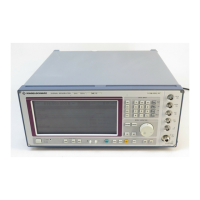SME Structure and Syntax of the Messages
1038.6002.02 3.7 E-13
Some key words occur in several levels within one command system. Their
effect depends on the structure of the command, that is to say, at which
position in the header of a command they are inserted.
Example: SOURce:FM:POLarity NORMal
This command contains key word POLarity in the third
command level. It defines the polarity between modulator and
modulation signal.
SOURce:FM:EXTernal:POLarity NORMal
This command contains key word POLarity in the fourth
command level. It defines the polarity between modulation
voltage and the resulting direction of the modulation only for the
external signal source indicated.
Optional key words: Some command systems permit certain key words to be optionally inserted
into the header or omitted. These key words are marked by square
brackets in the description. The full command length must be recognized
by the instrument for reasons of compatibility with the SCPI standard.
Some commands are considerably shortened by these optional key words.
Example: [SOURce]:POWer[:LEVel][:IMMediate]:OFFSet 1
This command immediately sets the offset of the signal to 1
volt. The following command has the same effect:
POWer:OFFSet 1
Note: An optional key word must not be omitted if its effect is specified
in detail by a numeric suffix.
Long and short form: The key words feature a long form and a short form. Either the short form
or the long form can be entered, other abbreviations are not permissible.
Example: STATus:QUEStionable:ENABle 1= STAT:QUES:ENAB 1
Note: The short form is marked by upper-case letters, the long form
corresponds to the complete word. Upper-case and lower-case
notation only serve the above purpose, the instrument itself
does not make any difference between upper-case and
lower-case letters.
Parameter: The parameter must be separated from the header by a "white space". If
several parameters are specified in a command, they are separated by a
comma ",". A few queries permit the parameters MINimum, MAXimum and
DEFault to be entered. For a description of the types of parameter, refer to
Section 3.5.5.
Example: SOURce:POWer:ATTenuation? MAXimum
Response:
60
This query requests the maximal value for the attenuation.
Numeric suffix: If a device features several functions or features of the same kind, e.g.
inputs, the desired function can be selected by a suffix added to the com-
mand. Entries without suffix are interpreted like entries with the suffix 1.
Example: SOURce:FM:EXTernal2:COUPling AC
This command sets the coupling of the second external signal
source.

